Abstract
The aging communities within traditional historical and cultural districts in the post-epidemic era face numerous challenges, including declining vitality, deteriorating environments, sluggish economies, and heightened public health risks. This paper aims to explore strategies for promoting the internal self-development of aging communities and enhancing their resilience. It analyzes the resilience of these communities through four dimensions: social factors, built environments, economic factors, and ecological environments. Using the Sizhou’an community in China as a case study, this paper examines the underlying causes of vulnerability and proposes renewal strategies. These strategies include stimulating the vitality of elderly groups, improving the community’s spatial environment, leveraging regional cultural advantages, and establishing urban community agricultural gardens. Furthermore, it presents a community renewal model characterized by “government guidance + community leadership + capital introduction + resident participation” to bolster community resilience and vitality, thereby ensuring sustainable development.
1. Introduction
China is currently undergoing a rapid period of population aging. By the end of 2023, the population aged 60 and above reached 296.79 million, accounting for 21.1% of the total population, while those aged 65 and above totaled 216.76 million, representing 15.4%. According to the standards set by the World Health Organization, a country or region is classified as an aging society when the proportion of the population aged 60 and above reaches 10% of the total population, or when the proportion of those aged 65 and above reaches 7%. Furthermore, a population in which 14% of individuals are aged 65 and above is classified as a moderately aging society, while a proportion of 21% indicates a severely aging society. The current data suggest that China has entered a moderately aging society. Aging communities are an inevitable consequence of the trend toward an aging population. This demographic shift not only brings profound changes to social structures but also poses new challenges for community governance. The overlapping effects of traditional historical and cultural districts with aging communities further exacerbate the complexity of the issue.
Traditional historical and cultural districts refer to areas characterized by preserved cultural relics, concentrated historical buildings, and an authentic reflection of traditional layouts and historical features, all while maintaining a certain scale [1]. These districts serve as typical carriers of aging issues. Due to an outdated material environment and a significant outflow of the middle-aged and young labor force, the proportion of elderly residents is markedly higher than in other communities, thereby diminishing the community’s vitality. Housing in aging communities often has a long history, particularly in traditional historical and cultural districts, which encompass residences from various historical periods. The diversity of housing types presents considerable challenges for renewal and governance. Additionally, due to the decline in physical functions and labor capacity associated with aging, elderly individuals are particularly vulnerable and often demonstrate a low willingness to engage in employment. Some elderly residents have limited economic income, necessitating community assistance and support. Furthermore, the infrastructure is insufficient, characterized by narrow public spaces, low green coverage, congested roads, and a mix of pedestrian and vehicular traffic. These deficiencies significantly hinder the ability to respond effectively to sudden public health emergencies.
To address the challenges posed by an aging population, the World Health Organization advocates for the development of age-friendly communities that foster a healthy environment for aging, enabling elderly individuals to lead healthier lives. In this context, various sectors have engaged in exploring and implementing governance strategies for aging communities. Research has primarily focused on analyzing the behavioral characteristics of elderly individuals and their living environments [2], as well as examining aspects such as physical and mental health, social environments [3,4], psychological needs, healthy communities [5], spatial accessibility, quality of life [6], and the overall suitability of communities for aging. However, these studies are discussed by experts from their respective perspectives, resulting in a lack of a comprehensive and unified framework to showcase this field. The pursuit of establishing a unified principle has led to the development of research on communities toward comprehensiveness.
The COVID-19 pandemic has posed significant challenges to the social and economic development of countries, exerting unprecedented pressure on urban communities characterized by limited interpersonal communication and reduced space for activities. Aging communities are particularly susceptible to virus transmission due to deteriorating built environments, outdated infrastructure, and insufficient public spaces [7]. Their capacity to respond to sudden public health emergencies has been severely tested. This pandemic has highlighted the vulnerabilities of aging communities and provided an opportunity to reassess the resilient development of urban community spaces [8,9,10].
The arrival of the post-pandemic era has introduced a new dimension to the governance of aging communities. As key providers of elderly care environments and public services, communities bear significant responsibility for supporting this demographic [11]. The economic and social activities of the elderly population have been profoundly impacted, drawing attention to the ability of aging communities to withstand sudden public health crises. As China’s aging population continues to grow, the sustainable development of vitality, health, safety, and resilience in aging communities will become a focal point for future urban community planning and governance. The COVID-19 pandemic has shifted research toward understanding community dynamics, specifically focusing on how to foster self-development within communities and maintain the basic living order of residents in the face of public health emergencies.
The concept of resilience originated in engineering and has since evolved to encompass ecological and social dimensions, reflecting notions of stability, balance, and adaptability. This multifaceted concept is recognized across various disciplines. The National Academy of Sciences defines resilience as the capacity to prepare for, plan for, absorb, recover from, and adapt more successfully to adverse events [12]. In discussing the fundamental characteristics of urban resilience [13], emphasis is placed on the ability to respond, recover, and adapt both before and after disasters, promoting transformation, innovation, and change as strategies to mitigate the impact of emergencies [14,15,16,17,18]. Vulnerability stands in contrast to resilience; thus, enhancing community resilience bolsters a community’s capacity to respond to disasters and risks, ultimately reducing overall vulnerability and facilitating timely responses and recoveries in the aftermath of disasters and other emergencies [19]. To strengthen community resilience, it is essential to accurately identify the core aspects of vulnerability, guide community transformation, and enhance the community’s ability to respond to risks. Research on community resilience also reflects the perspective of social factors, such as community policies [20], social participation, social support, social interests [21], and resource allocation [22]. However, research on the application of theory to practice, as well as the specific implementation framework, elements, and practical methods in resilience practice, remains insufficient. Some scholars have taken specific communities as case studies to construct a comprehensive framework for analyzing community resilience, assessing it from economic, social, cultural, political, and natural perspectives [23], thereby advancing the research on community resilience to a deeper level. However, comprehensive resilience analysis targeting aging communities remains insufficient.
There exists an inherent connection between the protection and renewal of traditional historical and cultural districts and the resilience-building of aging communities. On one hand, the spatial form and social networks of historical districts provide a cultural foundation for community resilience. Conversely, the deterioration of the material environment restricts resilience capacity. This contradiction necessitates research aimed at balancing protection and development, exploring an updated approach that preserves the historical context while addressing the health and safety needs of the elderly population. Current challenges in the revitalization of aging communities include:
- (1)
- The resilience and vitality of these communities have been further diminished in the post-pandemic era.
- (2)
- A critical question arises: how can we effectively balance the protection and development of cultural districts during design updates, given the absence of a comprehensive and specific guiding framework?
- (3)
- In practice, the community renewal model remains predominantly government-led, lacking detailed policy guidance and a clear division of responsibilities. Additionally, low property management fees and insufficient alternative revenue sources in aging communities have led to a shortage of funds for community renewal. This raises the question: where will the funding for independent renewal originate?
- (4)
- The utilization rate of community public spaces remains low, and the conditions for environmental greening and sanitation are inadequate.
Based on this perspective, this study investigates the Sizhou’an community in China as an empirical case that exemplifies both typicality and particularity. Recognized as a provincial-level historical and cultural district, the community has an aging rate of 32.6% and retains built features from the Ming and Qing dynasties. However, it simultaneously faces the dual pressures of declining traditional functions and intensified aging during the modernization process. The study integrates an international community resilience assessment system and constructs an analytical framework aimed at enhancing the resilience of aging communities across four dimensions: social factors, built environments, economic factors, and ecological environments. We focus on resolving the contradiction between historical preservation and age-friendly renewal and explore a renewal path that can enhance public health emergency response capabilities while also activating the endogenous development momentum of the community. This interdisciplinary research endeavor holds significant theoretical value and practical significance for achieving multiple goals related to health, safety, and sustainable development in aging communities.
2. Materials and Methods
2.1. Research Design
This study employs a systematic review method to elucidate the development and evolution of community resilience and vulnerability. By utilizing community resilience assessment tools and integrating with the characteristics of aging communities, we construct a resilience analysis framework specifically for aging communities in the post-pandemic era. This framework encompasses four dimensions: social factors, built environments, economic factors, and ecological environments. The Sizhou’an community is selected as the case study area to investigate and illustrate the relevant factors influencing the resilience restoration of public spaces in older communities. On-site research is conducted within the community, employing participatory observation, semi-structured interviews, and other methodologies to gain insights into the current situation and challenges. A resilience analysis is performed from multiple dimensions, including social factors, built environments, economic factors, and ecological environments. Based on the results of the 5-point Likert scale survey questionnaire, SPSS29 software was used to summarize and analyze to identify areas of insufficient elasticity. Utilizing Baidu Maps (a public open map), the drawing software SketchUp 2019, and the rendering tool Lumion 10, the study visualizes the distribution and updated design of community spaces. This study uses Baidu Maps as a template and SketchUp 2019 drawing software to create community area maps and topographic maps and employs the rendering tool Lumion 10 to produce a 3D rendering effect, thereby visualizing the distribution and updated design of community spaces.
2.2. Resilience Analysis Framework for Aging Communities
The strength of community resilience can be assessed using various evaluation tools and models. Numerous countries have conducted research and discussions on this topic from multiple perspectives, resulting in the development of community resilience assessment tools that encompass social, economic, natural environment, built environment, infrastructure, systems, culture, and other dimensions, as shown in Table 1. There are 36 assessment tools listed in Reference [19] and 27 assessment tools in Reference [24], of which 14 are described in detail. Some tools overlap between the two references, with scales categorized into state, city, community, neighborhood, etc. Based on the research topics of “community renewal” and “aging community” presented in this paper, we selected communities as the scale and identified seven typical resilience tools from References [19,24]. The evaluation factors have been summarized into four categories: social, environmental, economic, and ecological.

Table 1.
Community resilience assessment tools.
By comparing and analyzing these dimensions, the assessment factors are categorized into four main categories: social, environmental, economic, and ecological. It is important to note that the dimensions in this assessment tool primarily originate from Western urban environments, which may differ from those in China. This study extracts commonalities and integrates them with empirical observations of the current characteristics of aging communities in traditional historical and cultural districts in China, thereby developing a multidimensional resilience assessment framework specifically tailored for aging communities in the post-pandemic era (Figure 1). This analysis is conducted across four dimensions: social factors, built environments, economic factors, and ecological environments, which are further refined to more specific levels. These factors interact and influence one another and are analyzed as an integrated system to ensure effective operation and application in the practices of community resilience renewal and governance.
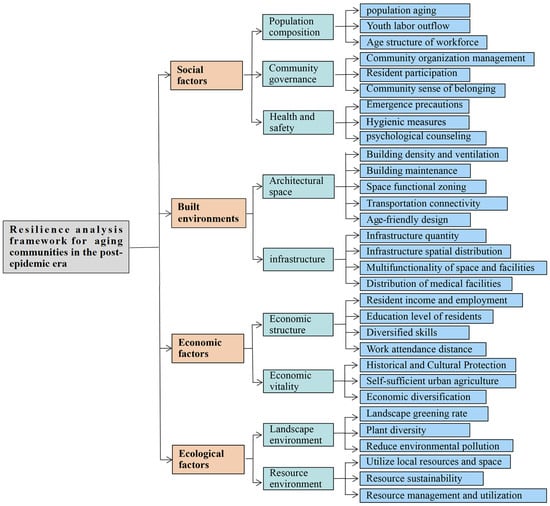
Figure 1.
Resilience analysis framework for aging communities in the post-pandemic era.
2.3. Case Overview
The selected research case is the Sizhou’an community (Figure 2), located on Chengzheng Street in the Yuhu District of Xiangtan City, Hunan Province, China. This area, characterized as the old city zone, exhibits a notable aging phenomenon. The community is situated at No. 353 Chengzheng Street in the northern central area of Yuhu District, encompassing approximately 1.6 square kilometers. Its boundaries extend from Guanxiangmen Road in the east to Tongjimen Road in the west and from Xichunmen Road in the north to Yanjiang East Road adjacent to Xiangjiang Lake in the south. The area is home to several cultural relic protection sites, including the Yi Gate from the Tang Dynasty and the Liu Martyrs Temple, as well as residential buildings from the Ming Dynasty, Qing Dynasty, Republic of China, and other periods, all of which contribute to its rich traditional historical and cultural heritage. However, due to its long history and extended construction period, the community faces a series of challenges, including a deteriorating living environment, insufficient economic vitality, and health and safety hazards stemming from the severe aging of buildings and facilities.

Figure 2.
Map of the Sizhou’an community in China (base map: Baidu Maps).
2.4. Analysis of the Research Cases
Aging communities typically encounter challenges such as a significant increase in the elderly population, outdated building infrastructure, diminished economic vitality, and a deteriorating ecological environment. These factors highlight their vulnerability in effectively responding to sudden public health emergencies. This study conducts on-site research within the Sizhou’an community, utilizing tracking observation and on-site interviews with residents. The interviews were semi-structured, involving a sample size of nine participants, which included one community worker and eight community residents. Communication during the interviews was generally smooth. Among the eight residents, one was an elderly individual over 80 years old who could only communicate in the local dialect, resulting in average interview outcomes. Five elderly individuals around 60 years old experienced no language barriers and communicated effectively, while two individuals around 40 years old also faced no language barriers and exhibited smooth communication. Additionally, the study employs a resilience analysis framework specifically designed for aging communities in the post-epidemic era. The community’s vulnerability performance is summarized as follows:
2.4.1. Analysis of Social Factors
According to the latest data released by China’s Seventh National Population Census, the permanent resident population of Xiangtan City is 2,726,181, with 597,872 individuals aged 60 or older, constituting 21.93% of the city’s total population. Yuhu District, one of Xiangtan’s two primary urban zones, has a permanent population of 616,130 residents, among whom 112,292 are elderly citizens aged 60 and above, representing 18.23% of the district’s total population [25]. The Sizhou’an community, located in the center of Xiangtan City, north of Yuhu District, is the oldest urban area of Xiangtan City. The Sizhou’an community currently comprises 2667 households and has a permanent population of 6776 individuals. According to the sixth population census conducted in 2010, the community had 3588 households and a permanent population of 9300. Over the past decade, the community has experienced a population decline of over 27% year-on-year, highlighting significant demographic issues (Figure 3). The gender ratio within the community is relatively balanced (Figure 4). However, there are 2121 residents aged 60 and above, representing 31.3% of the total residential population. Compared to the proportion of the elderly population in Xiangtan City and Yuhu District, it indicates that the Sizhou’an community is experiencing severe aging. Notably, the elderly population aged 65 to 79 constitutes a substantial portion of those aged 60 and above. The outflow of the young and middle-aged labor force is pronounced, resulting in a high proportion of empty-nest elderly individuals, referring to middle-aged and elderly individuals who live alone after their children leave home.
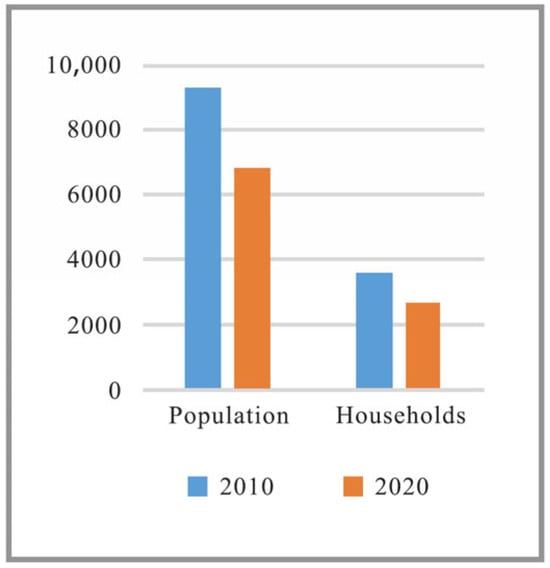
Figure 3.
Community population changes.
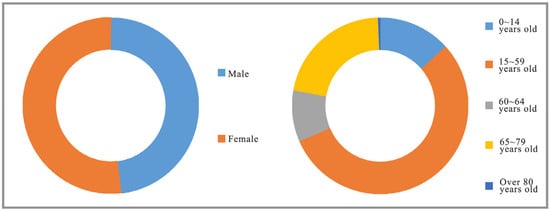
Figure 4.
Gender and age structure proportion of community residents.
Through the observation of the behavioral activities of 155 elderly individuals in the community, it was found that this population exhibits a high frequency and long duration of engagement in public spaces. The primary activities identified include sitting idly, chatting, walking, shopping, taking out the trash, drying clothes, selling items, collecting waste, and exercising. Among these, walking, chatting, shopping, and sitting idly are the most frequently observed activities, followed by work-related behaviors such as purchasing, selling, and repairing locks, as well as home labor activities such as disposing of garbage and drying clothes. Notably, the proportion of elderly individuals participating in fitness activities is relatively small (Figure 5). Overall, the behaviors and activities of elderly residents in the community predominantly revolve around home life, with individuals traveling either alone or with peers, while intergenerational relationships appear to be less active.
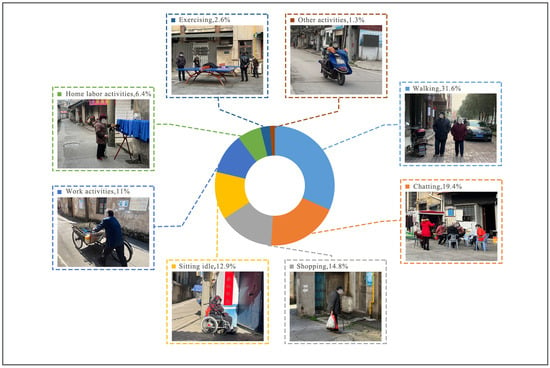
Figure 5.
The statistics on activity behaviors of elderly individuals in the Sizhou’an community.
2.4.2. Analysis of Built Environments
The internal architecture of the community features historical buildings from the Ming and Qing periods, alongside residential structures from the late Ming and Qing dynasties, unit-funded houses from the mid to late 20th century, and small commercial residential buildings that emerged following the reform and opening up. According to the different characteristics of these historical periods, the buildings can be categorized into four main eras: before 1840, 1840 to 1949, 1950 to 1999, and after 2000. The majority of these structures consist predominantly of low-rise and multi-storey dwellings, characterized by roofs adorned with green tiles, with some retaining traditional wooden frameworks. A limited number of modern high-rise buildings also exist. The architectural styles are diverse, and the buildings are densely intertwined, resulting in an overall layout that appears disorganized. Due to the prolonged existence of most buildings, their exteriors have significantly aged, and the foundations are often unstable. Furthermore, a substantial number of structures require demolition or repair, resulting in a deteriorated living environment. About 10% of the houses are severely damaged, and most of these residential buildings are inhabited by elderly people aged 60 and above. Additionally, some residential buildings have remained in disrepair for an extended period, posing safety hazards and introducing numerous unfavorable factors that affect residents’ daily lives and mobility (Figure 6).
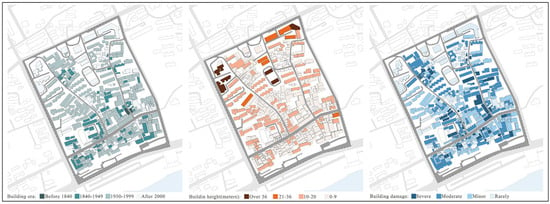
Figure 6.
The distribution of era, height, and damage to community buildings.
Public facilities play a crucial role in determining the quality of life in aging communities [26]. The absence of various supportive amenities, disorganized installation of power grid lines, and lack of auxiliary facilities, such as elevators in multi-story buildings, significantly hinder accessibility. Additionally, the community suffers from insufficient public fitness and entertainment facilities, along with a scarcity of leisure seating in public areas. Furthermore, there are only two small medical service institutions within the community, which are inadequate to effectively address residents’ needs for routine medical care and urgent public health emergencies.
2.4.3. Analysis of Economic Factors
The community and its surrounding areas are primarily residential, featuring a limited number of commercial facilities, such as street-facing shops along the main thoroughfare. This absence of sustainable industrial and large-scale commercial support has resulted in insufficient job opportunities, making it challenging for the young labor force to secure local employment, which in turn contributes to a significant outflow of labor. Additionally, the middle-aged and elderly populations exhibit low levels of education and limited labor skills. Some elderly individuals lack basic language proficiency and can communicate only in local dialects, resulting in average Mandarin communication skills and barriers to interaction with the outside world. The proportion of elderly individuals living alone is relatively high, and most of them lack a stable income, relying solely on subsistence allowances for their livelihood. Consequently, their quality of life is compromised, and the overall economic vitality of the community remains inadequate.
2.4.4. Analysis of Ecological Factors
The community’s public spaces are characterized by their scattered and narrow layout, with a notable absence of designated leisure activity squares. The narrow roads, congested dead ends, and poor spatial connectivity contribute to inadequate ventilation. Additionally, the road surfaces are damaged, and significant issues arise from residents occupying public spaces adjacent to residential buildings. The lack of separation between pedestrians and vehicles, combined with the random parking of vehicles along the roadside, further exacerbates the occupation of road space. Moreover, there is a deficiency of essential areas, such as parking lots, resulting in multiple safety hazards within the road space (Figure 7). Furthermore, community green spaces are disorganized and lack adequate planning; the localized hardened areas exceed recommended standards, while the overall greening area is insufficient, leading to a low greening rate. Collectively, these issues present serious safety and health risks to the community, underscoring its vulnerability.
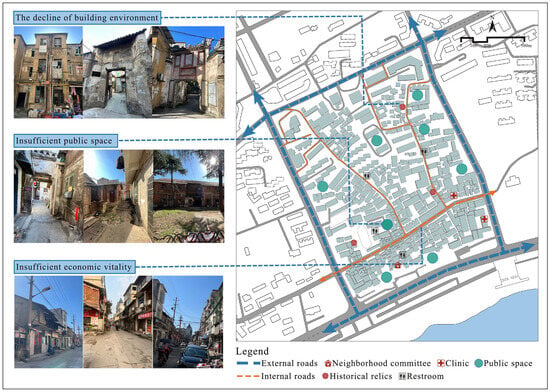
Figure 7.
Analysis of resilience in the Sizhou’an community.
2.5. Comprehensive Analysis Based on the Resilience Analysis Framework of Aging Communities
This study aims to design a questionnaire utilizing a 5-point Likert scale to evaluate and analyze community resilience, based on indicators defined in the resilience analysis framework for aging communities in the post-pandemic era. The variable settings align with the indicators, resulting in a total of 31 variables. Each variable is accompanied by corresponding questionnaire items. The selected variables and their classification descriptions are presented in Table 2. To enhance simplicity, variables have been abbreviated and labeled accordingly. For instance, the indicator for population aging within the social factors (SF) category corresponds to the variable SF01, with the questionnaire item labeled as ‘Age’. This systematic approach facilitates a comprehensive assessment of community resilience.

Table 2.
Variable selection and definition.
The survey targets the residents of Sizhou’an, including community workers, with a total of 130 questionnaires distributed and 116 valid responses collected. The valid sample represents 89.23% of the distributed questionnaires. This survey sample encompasses multiple age groups and types of personnel, ensuring that the collected data is accurate, effective, and representative. SPSS29 software was utilized to analyze the collected questionnaires.
Descriptive analysis provides insights into the minimum value, maximum value, mean, and standard deviation of the dataset. The mean serves as an indicator of central tendency; a higher score corresponds to greater satisfaction with the expressed content and increased resilience. The standard deviation reflects the degree of variability within the data. The results indicate that among 116 valid samples (see Table 3), residents exhibit the highest sense of belonging to the community, with a mean value of 3.16. Conversely, the lowest evaluations pertain to historical and cultural protection, as well as the outflow of young people, which have mean values of 2.25 and 2.41, respectively. The concentration of other variables generally hovers around 2.7. These evaluation results align with the characteristics of the community’s population, spatial conditions, economic status, and other relevant factors, thus affirming their reliability. Notably, the standard deviation reveals significant disparities in education level and monthly income, with standard deviations of 1.050 and 1.097, respectively, indicating pronounced differences among community residents in these areas.

Table 3.
Descriptive analysis.
3. Results
This study conducts a comprehensive analysis of the current situation in the Sizhou’an community, focusing on challenges such as the aging population and the deterioration of the material environment. It presents a community renewal model characterized by “government guidance + community leadership + capital introduction + resident participation” to enhance the resilience of the community, leverage the value of the elderly population, reshape spatial resilience, and create a dynamic, healthy, safe, and resilient community environment that supports sustainable development. The design strategy for resilience renewal in aging communities is outlined as follows:
3.1. Stimulating the Vitality of the Elderly Population and Restructuring the Resilience of the Social Structure
The opinions of the State Council of China on strengthening aging work in the new era emphasize the necessity of proactively addressing population aging by promoting both active and healthy aging. It advocates for the integration of elderly care with community support to facilitate the high-quality development of aging initiatives [27]. To enhance the development of aging communities, it is recommended that communities establish comprehensive resident information files, with a particular focus on managing information pertinent to the elderly population. According to the classification and management of employment needs and individual behavioral capabilities, elderly individuals in the community are categorized into three groups: those who are physically healthy and capable of working (accounting for 72%), those who can care for themselves but are unable to engage in labor (accounting for 26.5%), and those who are completely unable to care for themselves (accounting for 1.5%) (Figure 8). For the elderly who are healthy and capable of working, the community offers job opportunities and encourages participation in community governance and developmental construction, either on a voluntary or paid basis. For those who can manage their daily lives but lack the capacity for labor, we advocate for home-based elderly care, complemented by regular community visits for support and companionship. Additionally, we organize personnel to assist elderly individuals living alone within this category. For elderly individuals who are entirely unable to care for themselves, the community has attracted investments to establish elderly care facilities, such as apartments, and has employed local personnel to provide necessary care. This coordinated approach aims to enhance governance, increase the income of elderly individuals, elevate their social value and recognition, and ultimately improve their quality of life.
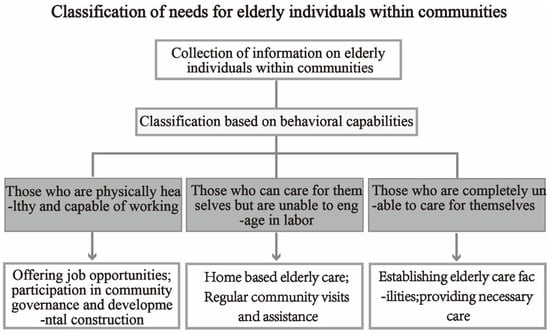
Figure 8.
Classification of needs for elderly individuals within communities.
To build an age-friendly community (Figure 9), it is essential to foster an atmosphere of care for the elderly. This can be achieved by encouraging elderly individuals to engage in communication, actively participate in community organization activities, and strengthen interactions among neighbors and different generations. In response to the national initiative advocating for a healthy aging lifestyle, we should focus on enhancing immunity and promoting capabilities through appropriate labor and physical exercise. Additionally, it is crucial to improve the medical support service system to adequately address the healthcare needs of elderly residents within the community. Attracting diverse funding sources will facilitate the collaborative construction of community elderly care institutions, such as senior apartments and nursing homes, thereby enhancing the overall elderly care services available in the community.
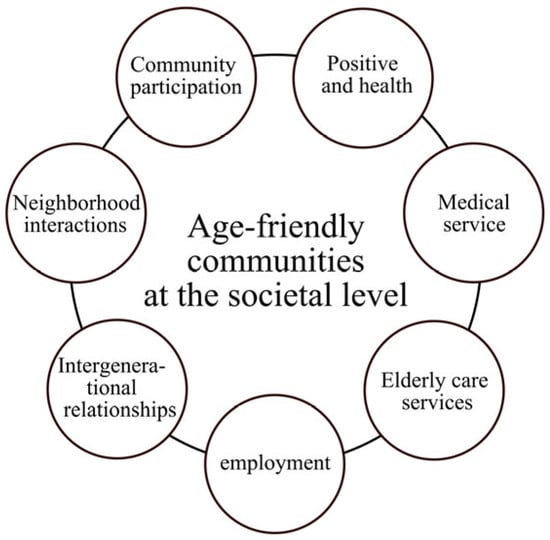
Figure 9.
Age-friendly communities at the social level [28].
3.2. Improving Community Space Environment and Enhancing Built Environment Resilience
3.2.1. Optimizing the Community Road System
Based on the existing streets and alleys, it is recommended to moderately widen the driving roads within the community. This adjustment will facilitate the smooth passage of both emergency vehicles and daily commuting vehicles. Additionally, it is essential to utilize idle spaces effectively. By integrating the planning of public parking lots with roadside parking areas, we can address the issue of roadside parking encroaching on public roads.
Statistics indicate that walking is the predominant form of physical activity among the elderly in the community. Therefore, it is crucial to open dead-end roads and plan leisure and fitness walking paths to accommodate the safe walking needs of elderly residents. Furthermore, pedestrian paths should be designed to connect historical relics with residential buildings within the community, serving both leisure walking and sightseeing purposes (Figure 10).
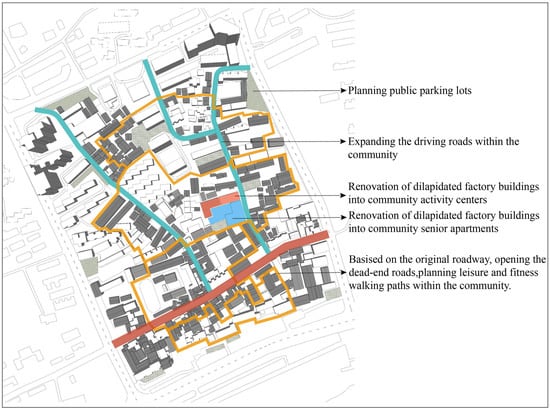
Figure 10.
Optimization diagram of roads within the community.
3.2.2. Renewal of Architectural Space and Facilities
On one hand, the tightening of local property market policies in recent years, coupled with a shortage of local financial resources following the COVID-19 pandemic, has influenced community planning. On the other hand, there is a commitment to preserving traditional historical residential buildings. In the short term, the community will refrain from large-scale demolition and reconstruction projects, as well as from constructing new high-rise buildings. Instead, the focus will be on rebuilding mid- to low-rise structures. The overall approach emphasizes the renovation, expansion, and minor updates of severely dilapidated buildings, which may include demolishing illegal constructions that obstruct access, renovating residential facades, leveling and hardening the ground, and installing natural gas pipelines.
The residential performance of community buildings will be evaluated based on existing national and local building assessment and update standards. An assessment of the extent of damage to each building will guide appropriate actions for necessary demolition, repair, or construction. Adhering to the principle of protecting historical buildings and cultural relics, efforts will be made to maintain their original appearance and materials (Figure 11). Furthermore, it is essential to keep building corridors free of debris to ensure unobstructed passage. Specific measures for updating building facilities will include the maintenance and replacement of internal and external drinking water and sewage pipelines, reinforcement and repair of internal staircases, enhancement of internal and external lighting systems, waterproofing of building roofs, repair of damaged floors, and the design of sponge city systems.
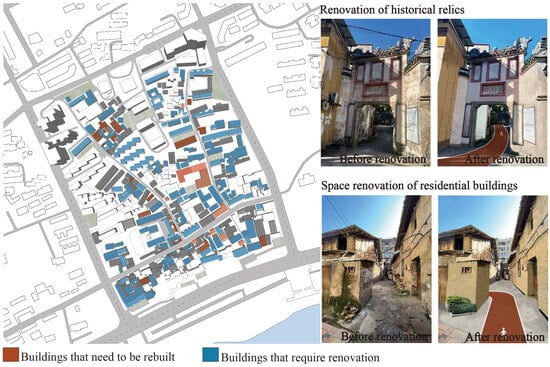
Figure 11.
Renovation of the community’s architectural space.
3.2.3. Adapting Aging and Renewal of Building Spaces
This section focuses on the physical and behavioral characteristics of the elderly, emphasizing the critical need to enhance the construction of age-friendly facilities within the community. We aim to address their diverse needs related to living, mobility, leisure, entertainment, and fitness. Our objectives include improving the living environment, enriching leisure activities, and fostering a community that is both age-friendly and livable.
Specific measures include converting dilapidated factory buildings within the community center into senior apartments and community activity centers (Figure 12); enhancing accessibility features in stairways, corridors, and public spaces within older buildings; improving lighting and ventilation; installing ramps and handrails at building entrances; adding elevators to mid-rise and high-rise structures; developing a comprehensive community signage system; creating dedicated leisure and entertainment areas; and planning fitness trails and pocket parks.
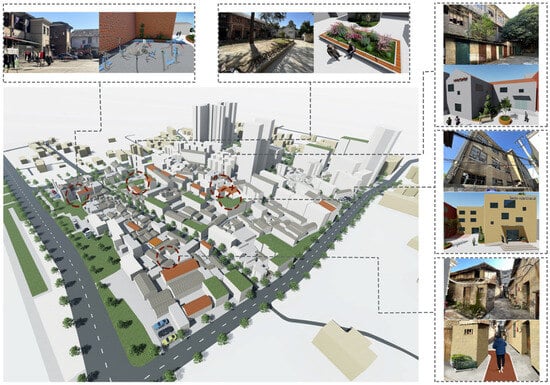
Figure 12.
Age-friendly renewal within the community.
3.3. Leveraging the Advantages of Regional Culture and Deepening the Resilience of Industrial Economy
Aging communities situated in traditional historical and cultural districts exhibit distinctive regional architectural styles and street layouts, which have evolved through prolonged periods of construction and historical development [29]. These characteristics confer significant historical and cultural advantages. By leveraging regional architecture, street layouts, and local customs and traditions, we can thoroughly explore and emphasize our unique attributes. It is essential to judiciously utilize community cultural resources, integrating them with the tourism industry to revitalize the community’s industrial economy and enhance its economic resilience. Older residents, often the original inhabitants of the community, retain a profound memory of the area’s history and culture. They serve as living repositories of regional narratives, encompassing numerous historical tales that remain unwritten and are transmitted orally. By fostering regional culture, the community can generate employment opportunities for elderly individuals in various roles, such as community cultural guides, performers of regional arts, hygiene and cleanliness coordinators, order managers, and vendors of specialty products.
It is advisable to encourage the transformation of ground floors in residential buildings to facilitate a transition from residential to commercial use, thereby developing small commodity formats along pedestrian streets that cater to the daily needs of residents and the shopping preferences of tourists. The pandemic has heightened individuals’ reliance on the internet, making live streaming a novel method for dissemination and sales. Communities can promote and support the elderly in learning and sharing local culture through live streaming platforms. These measures not only disseminate the historical and cultural heritage of the community but also provide opportunities for the elderly to re-enter the workforce, thereby improving their economic circumstances. This approach enhances economic benefits for both residents and the community, stimulates the local industrial economy, attracts young and middle-aged labor to return, and achieves a “reverse growth” of aging communities.
As the aging population in the country deepens, the needs of the elderly have garnered increased attention. The latest “Opinions on Developing the Silver Hair Economy and Enhancing the Welfare of the Elderly”, issued by the State Council of China, advocates for the development of the “silver hair economy” [30]. The demand for age-friendly products, elderly care services, smart elderly care solutions, and healthy aging initiatives not only addresses the differentiated, diversified, and personalized needs of the elderly but also necessitates technical service support from the younger generation. In parallel with expanding domestic demand within the community, it is essential to stimulate internal consumption, connect external links, and achieve a dual circulation of internal and external economies, with the internal economy serving as the primary focus and the external economy functioning as a supplement.
3.4. Building Community Garden Farms to Enhance Ecological Resilience
The community serves as the fundamental living environment for residents, particularly with the implementation of 15 min and 10 min living circles that increasingly prioritize convenience and perfection in community construction. The daily activities of elderly individuals primarily depend on and revolve around their communities. Following the outbreak of the epidemic, some urban communities adopted closed management practices, resulting in travel restrictions for residents, supply shortages, and significant disruptions to their daily lives. To enhance the resilience of aging communities, it is essential to optimize internal spaces by utilizing scattered green areas and rooftop spaces to establish small-scale garden farms within the communities (Figure 13). By introducing edible plants that also possess ornamental value, communities can create a short-term self-sufficient living circle, thereby reducing reliance on long-distance food supplies. Furthermore, engaging elderly individuals with specific agricultural skills to participate in community greening, planting, and youth labor education not only addresses social needs and fosters a sense of achievement among the elderly but also enhances intergenerational interaction and communication.
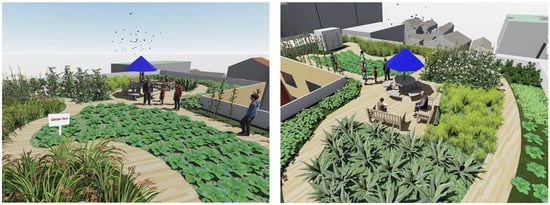
Figure 13.
Small-scale garden farms within the communities.
In the post-pandemic era, residents demonstrate an increasing desire for outdoor spaces and natural ecological environments. Communities can flexibly design parks, pocket parks at street corners, surrounding green spaces, building rooftops, and vertical gardens to create green healing spaces that can also function as emergency shelters during critical periods. By strategically planning green areas, increasing the greening rate of public spaces in aging communities, addressing residents’ recreational needs, expanding emergency shelter capacity, promoting ecological restoration, and enhancing ecological resilience, these efforts can significantly improve community well-being.
3.5. Mechanisms for Ensuring Resilience Governance and Renewal Implementation in Aging Communities
The resilient governance and renewal of aging communities necessitate the establishment of multiple stakeholders, including government guidance, community management, and resident participation. we propose a community renewal model characterized by “government guidance + community leadership + capital introduction + resident participation” in conjunction with community renewal design (Figure 14).
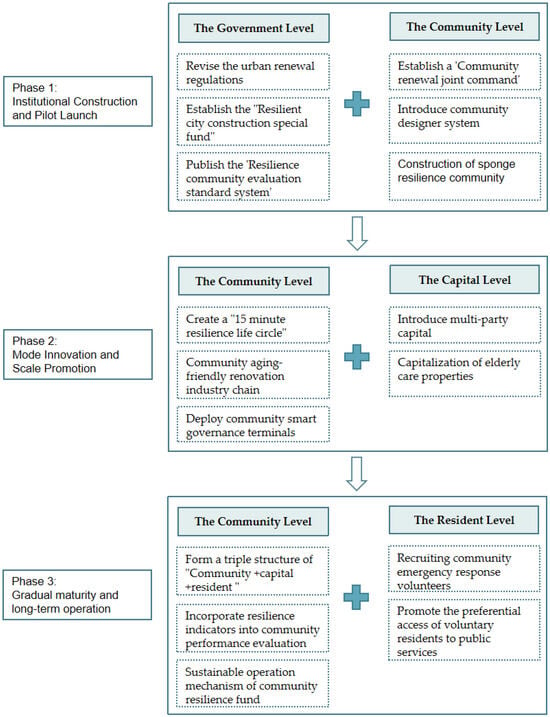
Figure 14.
Policy framework for proposed community renewal model.
In terms of policy, China proposes promoting new urban infrastructure to build resilient cities [31]. Hunan Province aims to create livable, resilient, and smart cities with individuals at the core to foster high-quality urbanization development [32]. Xiangtan City is committed to comprehensively advancing the construction of sponge cities, enhancing urban resilience and livability [33]. Through multi-level policy linkage, China is progressively building an integrated resilience governance network that encompasses the national, provincial, city, and community levels to enhance local resilience. A long-term guarantee mechanism is essential for fostering collaborative efforts aimed at sustaining community vitality. It is crucial to delineate the scope of responsibility and clarify the tasks assigned to all parties involved, moving away from the historically government-led community governance model [34]. This transition should fully harness the participation of community entities and residents. Furthermore, it is important to introduce industrial support within the community and attract diverse forms of social capital, including state-owned capital, private investments, and foreign investments, to engage in community governance and renewal. Supporting the development of diverse industries—such as real estate, community elderly care institutions, small businesses, and tourism—will ensure adequate funding for community resilience governance and renewal. Additionally, the introduction of standardized property management practices in community governance, combined with collaboration between community management personnel and residents, will facilitate joint governance and fully leverage the collective wisdom and efforts of the community.
4. Discussion
4.1. Effectiveness of Multidimensional Resilience Strategies
To promote the internal self-development of aging communities in traditional historical and cultural districts, we have constructed a resilience analysis framework tailored for these communities in the post-pandemic era. This framework encompasses four dimensions: social factors, built environments, economic factors, and ecological environments. By broadening the scope of community resilience analysis, it offers innovative insights for updating community resilience strategies. Using the Sizhou’an community in Xiangtan City as a case study, we propose a community renewal model characterized by “government guidance + community leadership + capital introduction + resident participation” in conjunction with community renewal design. This model aims to enhance the resilience and vitality of the community by consolidating the strength of the community itself, thereby revitalizing the aging community and achieving sustainable development.
With the intensification of aging, the proportion of elderly individuals in the community is increasing, and they are assuming an increasingly significant role. The World Health Organization advocates for the development of age-friendly communities, which create a healthy aging environment that enables elderly individuals to lead healthy lives. Through regional cultural dissemination, the construction of community garden farms, senior apartments, and resilience strategies for community activity centers, we aim to enhance the self-worth of the elderly. This initiative not only improves the quality of life for elderly individuals and enhances their social participation but also strengthens community cohesion. For instance, Japan officially entered an aging society in 1995, yet the term “silver economy” was first introduced in the 1970s. Since 2000, China has emphasized the need for equitable development within the elderly care industry. However, the willingness of elderly individuals to participate in community activities ultimately depends on their personal preferences.
Optimizing the architectural space of aging communities can significantly enhance the quality of life for residents. The architectural environment of the Sizhou’an community is outdated, with certain areas severely damaged and no longer suitable for habitation. However, due to its status as a traditional historical and cultural district, residential buildings cannot be demolished or rebuilt indiscriminately, complicating efforts to improve the living environment. It is essential to address the residents’ living needs while simultaneously preserving the district’s traditional historical and cultural characteristics. The renewal of the Pingjiang Road historical district in Suzhou exemplifies this approach by adhering to the principle of “restoring the old as before”, which aims to maintain local residential characteristics while transforming the area into a commercial tourist attraction. Nonetheless, to prevent overdevelopment, it is crucial to strike a balance between preservation and developmental updates.
Transforming regional culture into endogenous capital helps to establish an “endogenous economy” and reduces dependence on the external environment. However, excessive commercialization can lead to homogenization and a loss of local characteristics, as well as raise concerns regarding environmental pollution.
Community farm gardens can enhance both ecological and economic resilience in the post-pandemic era by providing safe food, promoting community self-sufficiency, and decreasing reliance on external economies. Additionally, these gardens serve educational purposes related to ecology and foster intergenerational communication. Nevertheless, it is essential to address considerations such as venue selection, personnel management, and financial expenses.
4.2. Feasibility and Challenges of Updating Modes
This research proposes an updated model of “government guidance + community leadership + capital introduction + resident participation”, which aims to balance the interests of multiple stakeholders through institutional design. For instance, in the case of Sizhou’an, the government can attract private investments in community commerce and elderly care by offering tax incentives and subsidies to small and microenterprises. This approach not only alleviates the financial burden on the community but also contributes to the development of the community and the well-being of elderly residents. This model resonates with the micro-renewal concept of “residents’ autonomy” observed in Beijing’s Dashilar Hutong [35], yet Sizhou’an Community places a stronger emphasis on the collaboration among communities, residents, and other stakeholders to achieve mutually beneficial outcomes. However, this model requires a high level of community organization, and loosely organized communities may encounter challenges related to low resident participation. Organizing activities for the elderly, such as calligraphy, handicraft making, and venue visits, can enhance connections among elderly individuals and foster community cohesion.
The drafting and implementation of resilience strategies are well-suited for community-led efforts, which can facilitate a smoother execution of resilience updates. Firstly, when government policies are enacted, communities are prioritized as the primary recipients. Secondly, community members tend to be more stable, reducing the likelihood of capital entities and resident groups withdrawing midway. Thirdly, community members possess a better understanding of local conditions. Fourthly, the identity of community members is more conducive to task assignment and supervision. In this framework, private capital and other entities function as investors, while residents serve as executors. For projects that involve multiple stakeholders, such as the commercial development facing the street on the first floor, democratic voting can be employed.
The effectiveness of resilience enhancement must be assessed through long-term tracking, as the current conclusions predominantly emphasize theoretical implications.
4.3. Research Limitations
The singularity of the selected case involves an aging community situated in a traditional historical and cultural district, characterized by its representativeness and uniqueness. However, this specific case cannot fully encapsulate the broader spectrum of aging communities, particularly regarding the utilization of cultural resources for economic revitalization.
The resilience analysis framework for aging communities warrants further optimization for comprehensive analysis and evaluation. This framework comprises numerous elements, and the study has identified key factors influencing aging communities across four dimensions: social factors, built environment, economic factors, and ecological environments. These include changes in population size, the degree of aging, building conditions, and the public environment. This survey utilized semi-structured interviews, facilitating smoother communication and yielding more truthful insights regarding residents’ willingness, but with a limitation in data volume.
For subsequent studies, it is advisable to select general communities or multiple communities across different regions for comparative analysis, thereby enhancing the universality of the findings. Within this overarching framework, specific elements can be selected for focused analysis, rendering the research outcomes more detailed and in-depth.
5. Conclusions
In the post-pandemic era, aging communities within traditional historical and cultural districts are confronted with numerous challenges, including declining vitality, environmental degradation, economic frailty, and heightened public health risks. Concurrently, these challenges introduce a new dimension to the governance of aging communities. By clarifying the concept of resilience and examining existing research on community resilience, this study seeks to identify innovative pathways for effective community resilience governance. The research employs a systematic review methodology, leveraging community resilience assessment tools while integrating the specific characteristics of aging communities in China.
This approach facilitates the construction of a resilience analysis framework tailored for aging communities in the post-pandemic context, encompassing four dimensions: social factors, built environments, economic factors, and ecological environments. Through participatory observation, semi-structured interviews, questionnaires, and other qualitative methods, this study focuses on the Sizhou’an community in China to analyze resilience and vulnerability across the aforementioned dimensions.
This analysis was conducted on the current situation of the Sizhou’an community in China, proposing a design strategy for revitalizing the resilience of aging communities in traditional historical and cultural districts. The strategy aims to stimulate the vitality of the elderly population and reconstruct the resilience of the social structure. It emphasizes improving the community spatial environment to enhance the resilience of the built environment, leveraging regional cultural advantages to deepen the resilience of the industrial economy, and establishing community garden farms to bolster ecological resilience. Furthermore, it advocates for a transition from government-led community governance and renewal to a community renewal model characterized by “government guidance + community leadership + capital introduction + resident participation”. This approach seeks to enhance community resilience, reshape spatial resilience, and create a dynamic, healthy, and safe community environment that supports sustainable development.
This paper discusses the effectiveness of multidimensional resilience strategies and proposes innovative research directions. Furthermore, it examines the feasibility and challenges associated with the resilience update model, clarifying the allocation of rights and responsibilities among the government, community, capital, and residents to foster collaboration and achieve mutually beneficial outcomes. Additionally, it addresses the limitations of the current analysis and research, such as the singularity of cases and the potential for further optimization for comprehensive analysis and evaluation. The resilience analysis framework encompasses multiple elements that cannot be demonstrated in isolation, highlighting areas where future research must achieve breakthroughs.
The renewal of aging communities necessitates a careful balance between optimizing the living environment and promoting sustainable community development, particularly during critical periods such as unexpected public safety incidents. Research on aging communities should prioritize a people-centered approach to community resilience governance and renewal strategies. A thorough analysis of specific issues within aging communities is essential to identify both commonalities and differences, which will inform the development of effective and reasonable solutions. Through community resilience governance and renewal, our objective is to revitalize these areas, enhance their resilience, and ensure the health and safety of residents. The future community embodies an era that primarily emphasizes resilience and recovery. Consequently, the transition from government-led community governance and renewal to a model characterized by “government guidance + community leadership + capital introduction + resident participation” highlights the importance of the community itself. This approach cultivates internal strengths, seeks external breakthroughs, and ultimately sustains the resilience and vitality of aging communities.
Author Contributions
M.R. and N.C. authors contributed equally to this work. All authors have read and agreed to the published version of the manuscript.
Funding
This research was funded by the Scientific Research Fund of Hunan Provincial Education Department, China, grant number CX20211029.
Data Availability Statement
The data supporting the conclusions of this article will be made available by the authors upon request.
Acknowledgments
We extend our thanks to the Sizhou’an community’s residents for welcoming us into their community.
Conflicts of Interest
The authors declare no conflicts of interest. The funders had no role in the design of the study; in the collection, analyses, or interpretation of data; in the writing of the manuscript; or in the decision to publish the results.
Correction Statement
This article has been republished with a minor correction to the existing affiliation information. This change does not affect the scientific content of the article.
References
- The Fujian Provincial People’s Government of China. What Is a Historical and Cultural District? Available online: https://www.fujian.gov.cn/hdjl/hdjlzsk/zjt/qt/202409/t20240910_6514543.htm (accessed on 15 February 2025).
- Yu, W.T.; Zhou, B.; Li, Z.B.; Fan, Y.; Luan, Y.F. Analysis of the difference of elderly activity venues selection in built residential areas: A case study of Dalian. Mod. Urban Res. 2020, 11, 123–129. [Google Scholar] [CrossRef]
- Yuan, M.Y. lmpact of urban residential aging modification on the health of household elderly: Analysis based on multilevel linear model. Urban Probl. 2022, 325, 73–82. [Google Scholar] [CrossRef]
- Zhou, Y.M.; Wang, C.Y. Research on exterior environmental design with good social atmosphere of elderly-friendly communities: A case study of a community in Beijing. Shanghai Urban Plan. Rev. 2020, 36, 15–21. [Google Scholar] [CrossRef]
- Zheng, Y.; Fang, K.L.; He, H.Y.; Yuan, Y. Research on the strategy of healthy community micro-regeneration from the perspective of age-friendly and child-friendly community: A case study of Sanyanjing community in Guangzhou. Shanghai Urban Plan. Rev. 2021, 1, 31–37. [Google Scholar] [CrossRef]
- Guida, C.; Carpentieri, G. Quality of life in the urban environment and primary health services for the elderly during the COVID-19 pandemic: An application to the city of Milan (Italy). Cities 2021, 110, 103038. [Google Scholar] [CrossRef]
- Mahendra, S.; Shilpi, M. Improvised rental housing to make cities COVID safe in India. Cities 2020, 106, 102922. [Google Scholar] [CrossRef]
- Parikh, P.; Diep, L.; Gupte, J.; Lakhanpaul, M. COVID-19 challenges and WASH in informal settlements: Integrated action supported by the sustainable development goals. Cities 2020, 107, 102871. [Google Scholar] [CrossRef]
- Reza, B. Pandemic and the planning of resilient cities and regions. Cities 2020, 106, 102929. [Google Scholar] [CrossRef]
- Kenneth, L.; Etienne, N.; Tony, B. ‘Transforming Freetown’: Dilemmas of planning and development in a West African City. Cities 2020, 101, 102694. [Google Scholar] [CrossRef]
- Yu, L.; Wang, Q. Concerns on provision of medical and aging service facilities from planning and design for adaptation to the elderly in community: A case of Xiamen. Urban Dev. Stud. 2020, 27, 26–31. [Google Scholar]
- Sharifi, A.; Yamagata, Y. On the suitability of assessment tools for guiding communities towards disaster resilience. Int. J. Disaster Risk Reduct. 2016, 100, 115–124. [Google Scholar] [CrossRef]
- Shomon, S. Resilience resistance: The challenges and implications of urban resilience implementation. Cities 2020, 103, 102763. [Google Scholar] [CrossRef]
- Alexander, D. Resilience and disaster risk reduction: An etymological journey. Nat. Hazards Earth Syst. Sci. 2013, 13, 2707–2716. [Google Scholar] [CrossRef]
- Boschma, R. Towards an evolutionary perspective on regional resilience. Reg. Stud. 2014, 49, 733–751. [Google Scholar] [CrossRef]
- Mendizabal, M.; Heidrich, O.; Feliú, E.; García-Blanco, G.; Mendizabal, A. Stimulating urban transition and transformation to achieve sustainable and resilient cities. Renew. Sustain. Energy Rev. 2018, 94, 410–418. [Google Scholar] [CrossRef]
- Meerow, S.; Stults, M. Comparing conceptualizations of urban climate resilience in theory and practice. Sustainability 2016, 8, 701. [Google Scholar] [CrossRef]
- Satterthwaite, D.; Dodman, D. Towards resilience and transformation for cities within a finite planet. Environ. Urban. 2013, 25, 291–298. [Google Scholar] [CrossRef]
- Sharifi, A. A critical review of selected tools for assessing community resilience. Ecol. Indic. 2016, 69, 629–647. [Google Scholar] [CrossRef]
- Lorenzo, C.; Aliaksandra, B. Understandings of urban resilience meanings and principles across Europe. Cities 2021, 108, 102985. [Google Scholar] [CrossRef]
- Martin, M.; Wendy, S.; Lauren, R.; Hartmut, F. Keywords in planning: What do we mean by ‘community resilience’? Int. Plan. Stud. 2016, 21, 348–361. [Google Scholar] [CrossRef]
- Alessandro, Z.; Omar, K.; Gian Paolo, C. Resourcefulness quantification approach for resilient communities and countries. Int. J. Disaster Risk Reduct. 2020, 46, 101509. [Google Scholar] [CrossRef]
- Geoff, A.W.; Markus, S.; Rike, S. The resilience and vulnerability of remote mountain communities: The case of Vent, Austrian Alps. Land Use Policy 2018, 71, 372–383. [Google Scholar] [CrossRef]
- Cutter, S.L. The landscape of disaster resilience indicators in the USA. Nat. Hazards 2015, 80, 741–758. [Google Scholar] [CrossRef]
- Xiangtan Municipal People’s Government of China. Xiangtan City Population Census Yearbook. Available online: https://xttj.xiangtan.gov.cn/uploadfiles/202305/2023052314510562905.pdf (accessed on 12 February 2025).
- Xie, B.; Wei, W.; Zhou, J. Senior community space evaluation and planning. Planners 2015, 31, 5–11+33. [Google Scholar]
- The Central Committee of the Communist Party and the State Council of China. Opinions on Strengthening Aging Work. Available online: http://www.gov.cn/zhengce/202111/24/content_5653181.html (accessed on 10 April 2022).
- Levasseur, M.; Dubois, M.F.; Généreux, M.; Menec, V.; Raina, P.; Roy, M.; Gabaude, C.; Couturier, Y.; St-Pierre, C. Capturing how age-friendly communities foster positive health, social participation and health equity: A study protocol of key components and processes that promote population health in aging Canadians. BMC Public Health 2017, 17, 502. [Google Scholar] [CrossRef]
- Wu, H.Z.; Lu, R.; Chen, G.Q.; Lu, L.; Tong, X. Feature creation and revitalization of the old urban area based on local culture: A case study on the urban design of western Pujiang area. City Plan. Rev. 2020, 44, 120–128. [Google Scholar] [CrossRef]
- The General Office of the State Council of China. Opinions on Developing the Silver Hair Economy and Enhancing the Welfare of the Elderly. Available online: https://www.gov.cn/zhengce/content/202401/content_6926087.html (accessed on 10 April 2022).
- The General Office of the Communist Party of China Central Committee and the General Office of the State Council. Opinions on Promoting the Construction of New Urban Infrastructure and Building Resilient Cities. Available online: https://www.gov.cn/zhengce/202412/content_6991173.htm (accessed on 12 February 2025).
- The People’s Government of Hunan Province in China. Building Resilient and Safe Cities to Enhance the “Happiness” of Urban Residents. Available online: https://www.hunan.gov.cn/hnszf/hnyw/sxsp/202408/t20240804_33420794.html (accessed on 12 February 2025).
- The People’s Government of Xiangtan City in China. Comprehensively Promote the Construction of Sponge Cities, Making Cities More Resilient and Livable. Available online: https://www.xiangtan.gov.cn/109/171/172/content_1340029.html (accessed on 12 February 2025).
- Fu, Q.; Zhang, X. Promoting community resilience through disaster education: Review of community-based interventions with a focus on teacher resilience and well-being. PLoS ONE 2024, 19, e0296393. [Google Scholar] [CrossRef]
- Jiang, X.; Xu, X.; Wang, X.; Lin, Q. Research on micro-renewal of green space in Beijing Hutong from the perspective of residents’ spontaneous renewal—Exploration in Dashilar area. Landsc. Archit. 2019, 26, 18–22. [Google Scholar] [CrossRef]
Disclaimer/Publisher’s Note: The statements, opinions and data contained in all publications are solely those of the individual author(s) and contributor(s) and not of MDPI and/or the editor(s). MDPI and/or the editor(s) disclaim responsibility for any injury to people or property resulting from any ideas, methods, instructions or products referred to in the content. |
© 2025 by the authors. Licensee MDPI, Basel, Switzerland. This article is an open access article distributed under the terms and conditions of the Creative Commons Attribution (CC BY) license (https://creativecommons.org/licenses/by/4.0/).